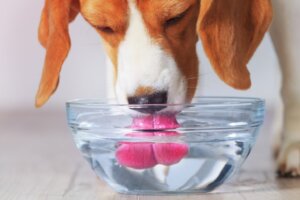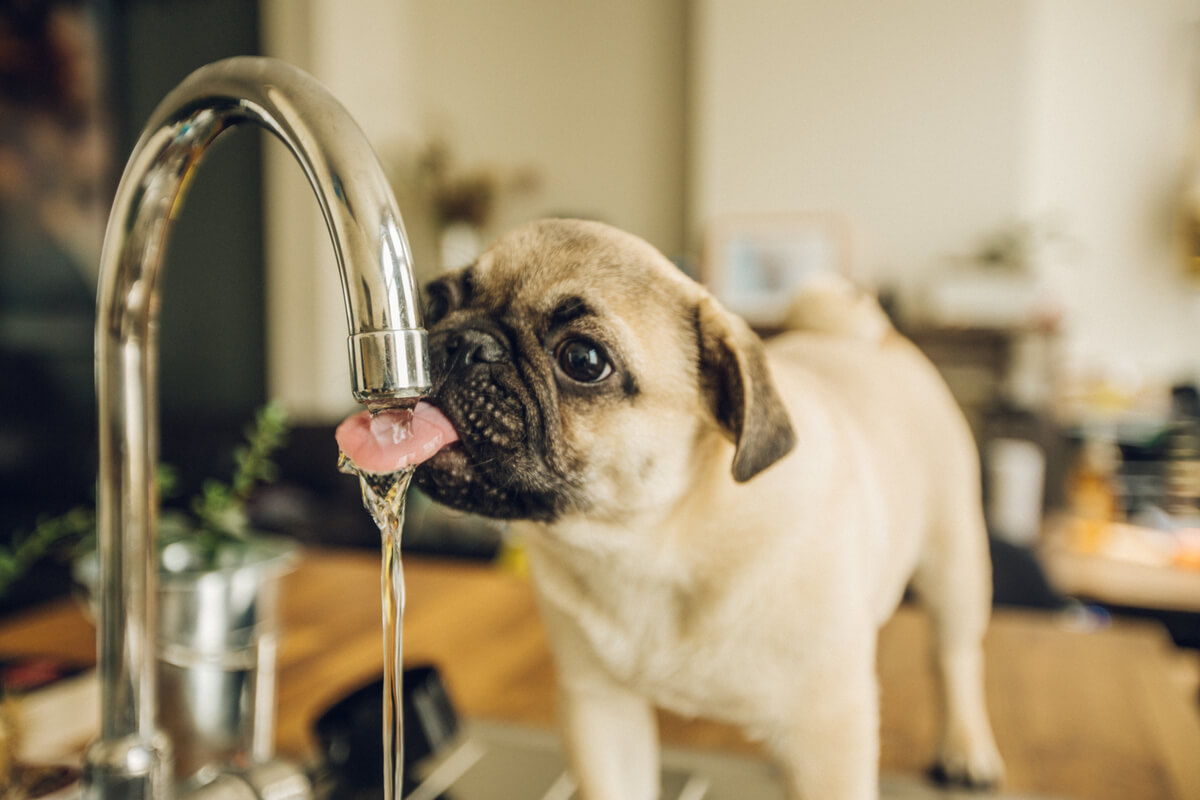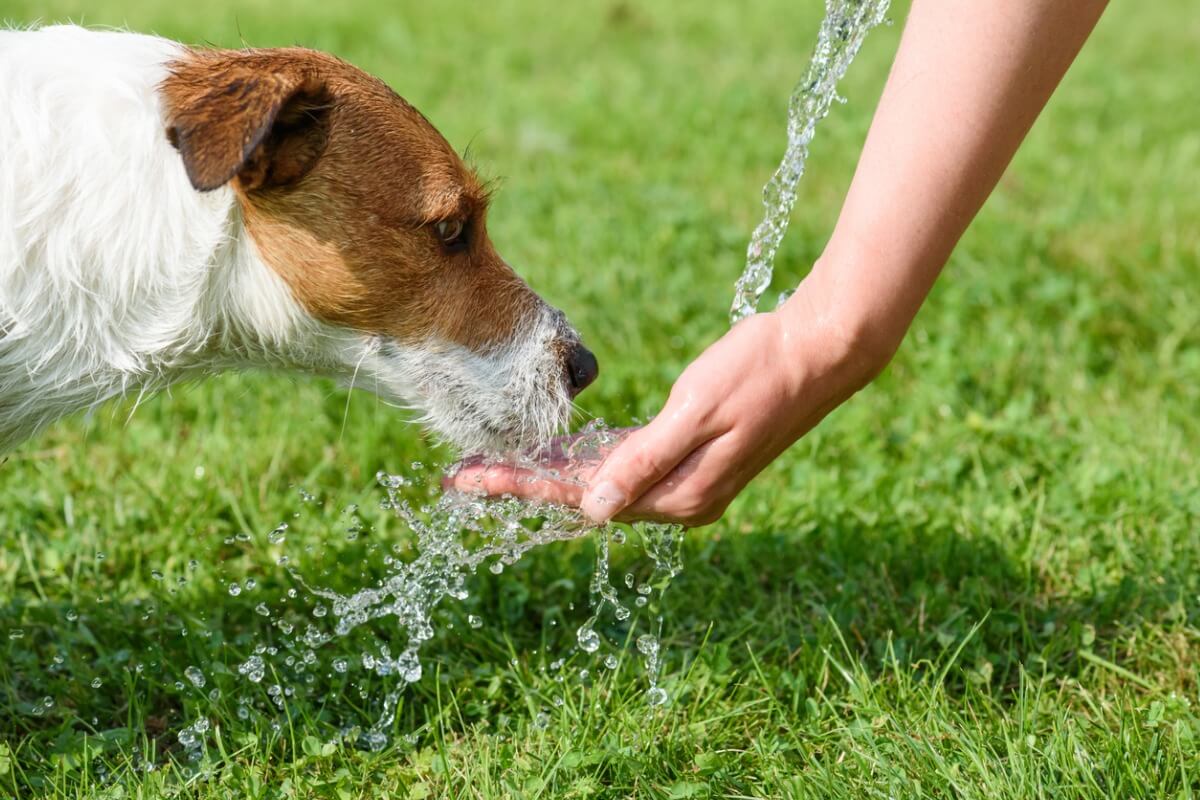How Much Water Does My Dog Need per Day?


Reviewed and approved by the biologist Samuel Sanchez
Although most owners recognize the importance of water consumption in dogs, it isn’t so easy to know the exact amount they should drink. In this article, we’re going to tell you how to calculate this and ensure that your dog stays well hydrated, which is essential for its health.
Water is a very simple nutrient, but the survival of all living things depends on it, due to it being vital for optimal primary biochemical processes to take place in our bodies. This liquid helps to regulate body temperature, process food, eliminate waste and lubricate the tissues, among many other things.
How much water should a dog drink per day?
There’s no exact amount of water that dogs should drink, but they’ll need to have fresh water at their disposal for whenever they need it. However, if you need to measure proportions, experts estimate that dogs should drink between 60 and 70 milliliters of water a day per kilogram of weight.
Even so, this measure may vary in times like summer, when dogs will drink more water than normal. The amount also varies according to lifestyle, especially if yours is a very physically active dog.

How to calculate the amount of water?
The easiest way to calculate how much water dogs should drink is by weight, with the rule that we mentioned above: 60-70 milliliters per kilogram. However, this isn’t the only way to make a rough estimate.
Experts say that it’s possible to identify the amount of water required based on how much dry food the dog eats. You need to multiply the weight of the dry food (in kilos) by 2.5. and that will give you how much water you should provide. For example, if your dog eats 1kg of dry food per day, you should provide 2.5 liters of water per day.
How do I know if my dog is dehydrated?
Providing your dog with the amount of water it should be consuming is no guarantee that it’ll actually drink it. Most owners only notice that their dog hasn’t been drinking enough water when they become ill or shows signs of dehydration, including the following:
- Dry muzzle and gums: A dog’s muzzle and gums need to stay moist. Therefore, when these areas become dry or “sticky”, then you can suspect possible dehydration. Also, look at the color of the gums (they should be pink, not red or white).
- Dark urine: A well-hydrated dog won’t have dark or cloudy urine and it shouldn’t have a strong smell. If you see that your dog’s urine is like this, then you’ll need to rule out possible infections (in addition to dehydration).
- Sunken eyes: This symptom indicates dehydration, so check your dog’s eyes when you suspect that they’re not drinking enough water.
- Loss of skin elasticity: As with humans, a dog’s skin also reflects their level of hydration. Check this condition by gently pinching your dog’s back. If it takes a while to return to its original shape, suspect dehydration.
- Accelerated breathing: This is one of the symptoms that most alarm owners. It occurs when dehydration affects the organic functioning of the pet.
Don’t delay in taking your dog to the vet when you notice that they have stopped drinking water and are showing signs of illness. It’s best to identify the cause of the dehydration and get your dog professionally treated before its life is in danger.
Water-related illnesses in dogs
So far we’ve talked about inadequate water intake, but what happens when your dog drinks too much or stops drinking water altogether? It’s common for owners to be alarmed if they notice that their dog isn’t drinking any liquid water, but they tend to calm down when they see them drinking enough again.
However, it should be clarified that both behaviors could be a sign that something is wrong with their health. Here are some diseases related to this behavior in dogs.
- Compulsive drinking: This disorder indicates an urgent need to drink water. Consumption is compulsive and excessive. It may be caused by mental problems in the dog or, as research suggests, a symptom of separation anxiety.
- Polydipsia: Polydipsia is a state of excessive thirst that occurs over a long period of time. It’s common in diabetic or intoxicated dogs and is accompanied by excessive urination (polyuria).
- Adipsia water loss: This is the absence of water intake associated with the lack of thirst signals. It can be a symptom of serious diseases such as hydrocephalus, congenital anomalies, tumors in the hypothalamus, or cerebrovascular problems.
Tips to promote water intake in dogs
If the owner notices that the dog isn’t consuming the amount of water they should, then they can implement some strategies to motivate them to do so. It doesn’t only have to be water, as it’s possible to supplement the daily hydration percentage with some foods such as the following:
- Fruits and vegetables: Those with a good percentage of water, such as carrots, pumpkin, apples, and papaya, among others, are ideal.
- Wet food: Depending on the brand, this food supplement will have about 70% water, so it’ll help keep your pet hydrated while feeding.
Additionally, identify why your dog doesn’t like to drink water from its bowl. The material the bowl is made of may be giving the water a bad taste (something that often happens with plastic drinking bowls). It’s also possible that the dog is more attracted to running water. In this case, consider installing a fountain or automatic waterer that constantly renews the water.
How much water do you give your dog?
Now you know more about how much water dogs need, you can check to see if your pet is drinking the right amount each day. If not, try some of the tips we’ve given you to stimulate them to drink. When you identify symptoms of dehydration or illness, go to a health professional.
On the other hand, remember that there are special conditions in which the dog will need to increase or decrease water intake. For example, lactating dogs require more liquid, as well as canines involved in intense physical training.

Whatever the case, keep one or two drinking bowls full with fresh water for your dog to access the liquid whenever they want. If you’re not sure as to whether or not your dog is drinking as much as they should, monitor them over the course of a couple of days. Take note of how much water you give them, and how much they consume per day and, if necessary, show the data to a veterinarian.
Although most owners recognize the importance of water consumption in dogs, it isn’t so easy to know the exact amount they should drink. In this article, we’re going to tell you how to calculate this and ensure that your dog stays well hydrated, which is essential for its health.
Water is a very simple nutrient, but the survival of all living things depends on it, due to it being vital for optimal primary biochemical processes to take place in our bodies. This liquid helps to regulate body temperature, process food, eliminate waste and lubricate the tissues, among many other things.
How much water should a dog drink per day?
There’s no exact amount of water that dogs should drink, but they’ll need to have fresh water at their disposal for whenever they need it. However, if you need to measure proportions, experts estimate that dogs should drink between 60 and 70 milliliters of water a day per kilogram of weight.
Even so, this measure may vary in times like summer, when dogs will drink more water than normal. The amount also varies according to lifestyle, especially if yours is a very physically active dog.

How to calculate the amount of water?
The easiest way to calculate how much water dogs should drink is by weight, with the rule that we mentioned above: 60-70 milliliters per kilogram. However, this isn’t the only way to make a rough estimate.
Experts say that it’s possible to identify the amount of water required based on how much dry food the dog eats. You need to multiply the weight of the dry food (in kilos) by 2.5. and that will give you how much water you should provide. For example, if your dog eats 1kg of dry food per day, you should provide 2.5 liters of water per day.
How do I know if my dog is dehydrated?
Providing your dog with the amount of water it should be consuming is no guarantee that it’ll actually drink it. Most owners only notice that their dog hasn’t been drinking enough water when they become ill or shows signs of dehydration, including the following:
- Dry muzzle and gums: A dog’s muzzle and gums need to stay moist. Therefore, when these areas become dry or “sticky”, then you can suspect possible dehydration. Also, look at the color of the gums (they should be pink, not red or white).
- Dark urine: A well-hydrated dog won’t have dark or cloudy urine and it shouldn’t have a strong smell. If you see that your dog’s urine is like this, then you’ll need to rule out possible infections (in addition to dehydration).
- Sunken eyes: This symptom indicates dehydration, so check your dog’s eyes when you suspect that they’re not drinking enough water.
- Loss of skin elasticity: As with humans, a dog’s skin also reflects their level of hydration. Check this condition by gently pinching your dog’s back. If it takes a while to return to its original shape, suspect dehydration.
- Accelerated breathing: This is one of the symptoms that most alarm owners. It occurs when dehydration affects the organic functioning of the pet.
Don’t delay in taking your dog to the vet when you notice that they have stopped drinking water and are showing signs of illness. It’s best to identify the cause of the dehydration and get your dog professionally treated before its life is in danger.
Water-related illnesses in dogs
So far we’ve talked about inadequate water intake, but what happens when your dog drinks too much or stops drinking water altogether? It’s common for owners to be alarmed if they notice that their dog isn’t drinking any liquid water, but they tend to calm down when they see them drinking enough again.
However, it should be clarified that both behaviors could be a sign that something is wrong with their health. Here are some diseases related to this behavior in dogs.
- Compulsive drinking: This disorder indicates an urgent need to drink water. Consumption is compulsive and excessive. It may be caused by mental problems in the dog or, as research suggests, a symptom of separation anxiety.
- Polydipsia: Polydipsia is a state of excessive thirst that occurs over a long period of time. It’s common in diabetic or intoxicated dogs and is accompanied by excessive urination (polyuria).
- Adipsia water loss: This is the absence of water intake associated with the lack of thirst signals. It can be a symptom of serious diseases such as hydrocephalus, congenital anomalies, tumors in the hypothalamus, or cerebrovascular problems.
Tips to promote water intake in dogs
If the owner notices that the dog isn’t consuming the amount of water they should, then they can implement some strategies to motivate them to do so. It doesn’t only have to be water, as it’s possible to supplement the daily hydration percentage with some foods such as the following:
- Fruits and vegetables: Those with a good percentage of water, such as carrots, pumpkin, apples, and papaya, among others, are ideal.
- Wet food: Depending on the brand, this food supplement will have about 70% water, so it’ll help keep your pet hydrated while feeding.
Additionally, identify why your dog doesn’t like to drink water from its bowl. The material the bowl is made of may be giving the water a bad taste (something that often happens with plastic drinking bowls). It’s also possible that the dog is more attracted to running water. In this case, consider installing a fountain or automatic waterer that constantly renews the water.
How much water do you give your dog?
Now you know more about how much water dogs need, you can check to see if your pet is drinking the right amount each day. If not, try some of the tips we’ve given you to stimulate them to drink. When you identify symptoms of dehydration or illness, go to a health professional.
On the other hand, remember that there are special conditions in which the dog will need to increase or decrease water intake. For example, lactating dogs require more liquid, as well as canines involved in intense physical training.

Whatever the case, keep one or two drinking bowls full with fresh water for your dog to access the liquid whenever they want. If you’re not sure as to whether or not your dog is drinking as much as they should, monitor them over the course of a couple of days. Take note of how much water you give them, and how much they consume per day and, if necessary, show the data to a veterinarian.
All cited sources were thoroughly reviewed by our team to ensure their quality, reliability, currency, and validity. The bibliography of this article was considered reliable and of academic or scientific accuracy.
- Camps, J. Agua, es imprescindible que los perros bebas ‘ad libitum’. El mundo del perro.
- Requerimientos Nutricionales en Perros y Gatos.
- Peñaranda, D. Ansiedad por separación en caninos llevado al lenguaje repertorial. Fundación Universitaria Escuela Colombiana de Medicina Homeopática Luis G. Páez. 2015.
- Mª T. Verde Arr-ibas, Mª C. Marca Andrés, S. García Belenguer, J. Aznar Chicote, C. Aceña Fabián, R. Díez González. Síndrome poliuria-polidipsia: ¿Cómo abordaría el diagnóstico? Revista de AVEPA. Vol. 9, Nº 2-1989.
This text is provided for informational purposes only and does not replace consultation with a professional. If in doubt, consult your specialist.








